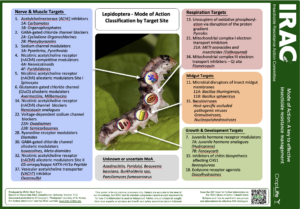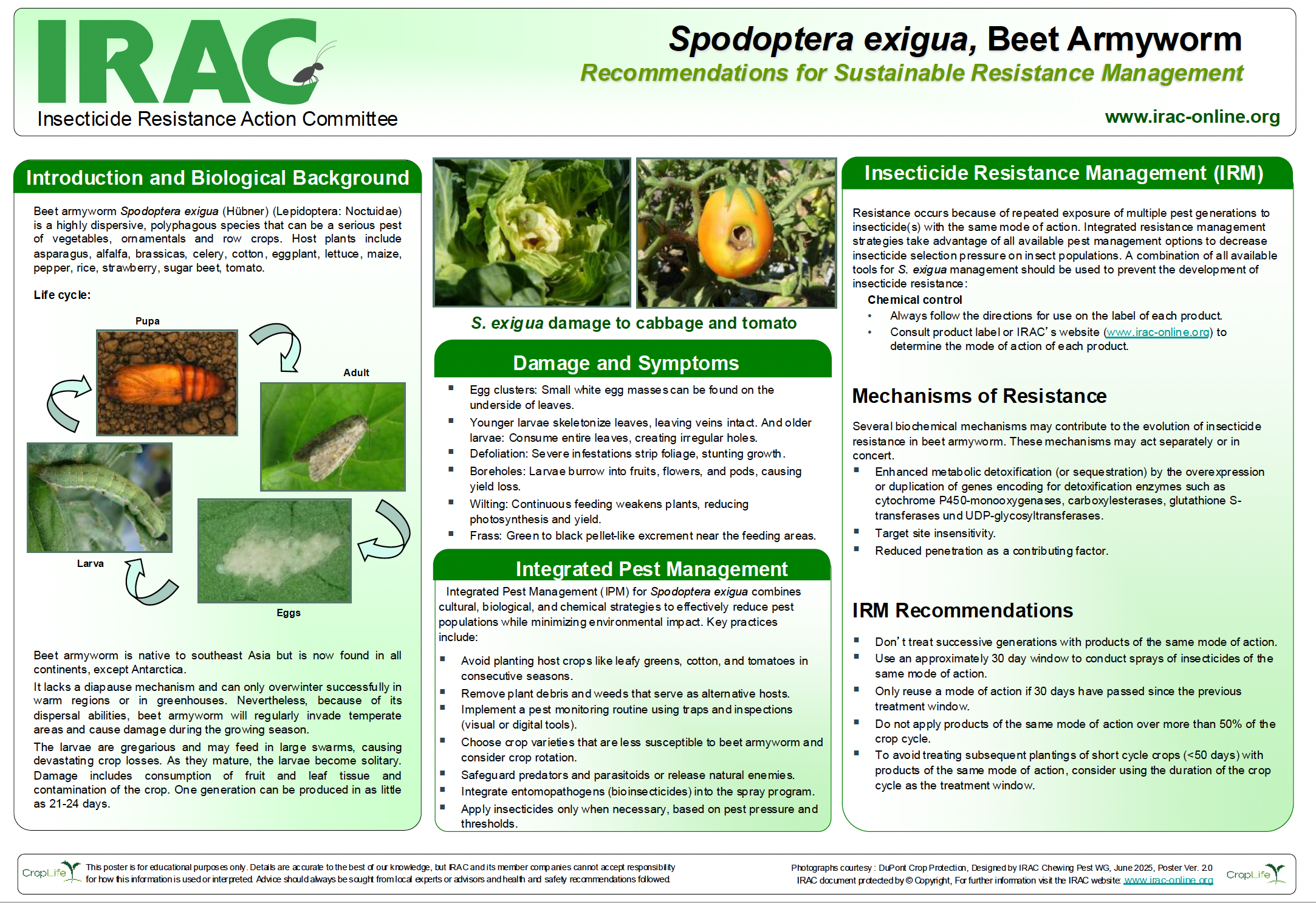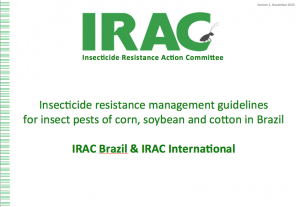Beet armyworm
Spodoptera exiguaSpodoptera exigua (Hübner) (Lepidoptera: Noctuidae) is a highly dispersive, polyphagous species that is a serious pest of vegetables, ornamentals and row crops. There are hundreds of known host plants including important crops like cabbages, pepper, tomato, lettuce, celery, strawberry, eggplant, sugar beet, alfalfa, and cotton
S. exiguais native to Southeast Asia but is now found in all continents, except Antarctica. It lacks a diapause mechanism and can only overwinter successfully in warm regions or in greenhouses. Nevertheless, because of its dispersal abilities, S. exiguawill regularly invade temperate areas and cause damage during the growing season. The larvae are gregarious and may feed in large swarms, causing devastating crop losses. Larvae feed on both foliage and fruit and cause contamination of the crop. As they mature, the larvae become solitary. One generation can be produced in as little as 21-24 days.
Integrated Pest Management (IPM)
Agronomic practices within integrated pest management aim to optimize crop yield while minimizing environmental impact, ensuring the long-term sustainability of the agroecosystem.
Limit the presence of alternative host crops or weeds. Implement crop rotation with non-host species. Manage volunteer plants and remove crop residues to control Spodoptera exigua, which can also thrive in weeds.
A successful IPM strategy depends on consistent monitoring of both the target pest and the extent of damage. Economic thresholds differ based on the specific crop and regional geography. It is advisable to consult local research institutions and universities to determine suitable threshold levels for the area. Monitoring should include assessing the number of moths captured in traps, counting the larvae per designated quantity of plants, or measuring the percentage of defoliation or damaged flowers and fruits, while aligning this information with a cost-benefit analysis concerning treatment costs, pest population trends, and the prevention of economic loss for the grower.
The identification of natural enemies present in the area and their population levels must be considered when deciding on the most appropriate control method. In protected crops, environmental manipulation through irrigation, greenhouse ventilation, and greenhouse plastic selection can facilitate the establishment and multiplication of the beneficial organisms. For instance, entomopathogenic fungi and entomopathogenic nematodes are favored by high humidity conditions and effective irrigation management. Conversely, extremely low or high temperatures, as well as water stress, tend to be unfavorable for certain entomopathogens.
Biological control through mass release needs to be combined with a planned selection of agrochemicals, prioritizing the choice of selective products. Always consult the insecticide label and adhere to the application guidelines, which include dosage, timing, calibration of spraying equipment, safety measures, and the Insecticide Resistance Management recommendations.
Beet armyworm resistance profile
Spodoptera exigua resistance cases were reported in several countries in Asia and the Americas, related to a wide range of active ingredients.
Several biochemical mechanisms may contribute to the evolution of insecticide resistance in beet armyworm. These mechanisms may act separately or in concert.
Typical mechanisms are:
- >Enhanced metabolic detoxification (or sequestration) by the overexpression or duplication of genes encoding for detoxification enzymes such as cytochrome P450-monooxygenases, carboxylesterases, glutathione S-transferases and UDP-glycosyltransferases.
- >Target site insensitivity.
- >Reduced penetration as a contributing factor.
| Species | Distribution | Chemical class | Mechanisms |
|---|---|---|---|
| Spodoptera exigua | Mexico, USA | Carbamates (1A) | Not specified |
| Spodoptera exigua | China, Mexico, Pakistan, USA | Organophosphates (1B) | |
| Spodoptera exigua | China, Pakistan | Cyclodiene organochlorines (2A) | |
| Spodoptera exigua | China, Mexico, Pakistan, USA, Guatemala | Pyrethroids-Pyrethrins (3A) | Mutation in VGSC (Voltage-gated sodium channel; Cytochrome P450 overexpression, CYP 321A8; Metabolic - detoxification enzimes (monooxygenases and esterases), |
| Spodoptera exigua | China, Mexico, Pakistan | Spinosyns (5) | Metabolic- detoxification enzimes (monooxygenases); cytochrome P450 |
| Spodoptera exigua | China, Pakistan | Avermectins (6) | Metabolic - cytochrome P450, enzyme CYP9A186 |
| Spodoptera exigua | Pakistan | Pyrroles-Dinitrophenols-Sulfuramid (13) | Not specified |
| Spodoptera exigua | China, Pakistan | Benzoylureas (15) | |
| Spodoptera exigua | China, Mexico, Pakistan | Diacylhydrazines (18) | Metabolic- detoxification enzimes (oxydases, hydrolases) |
| Spodoptera exigua | China, Pakistan | Oxadiazines (22A) | |
| Spodoptera exigua | China | semicarbazones (22B) | |
| Spodoptera exigua | China, South Korea, USA | Diamides (28) | Target site (mutation I4743M; I4790M) |
| Spodoptera exigua | China | Compounds of Unknown or Uncertain MoA (UN) | Not specified |


